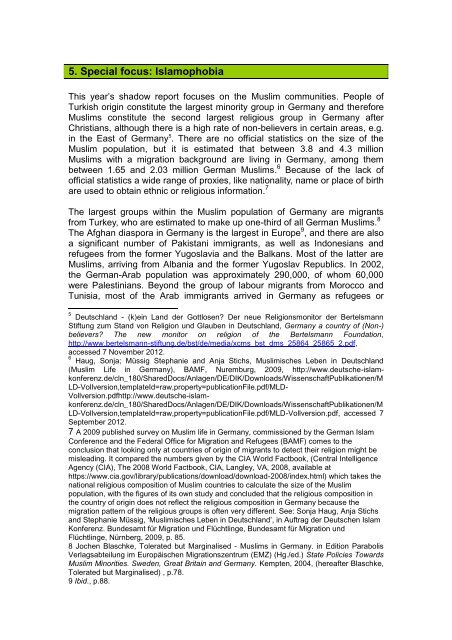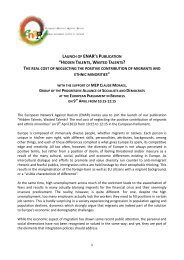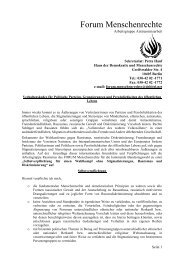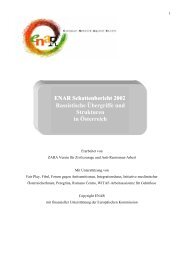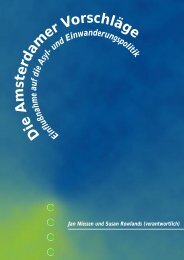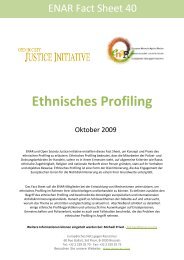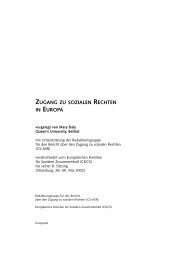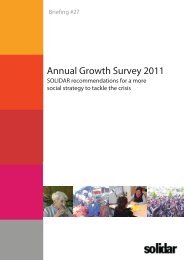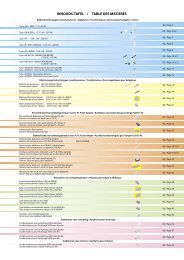Germany - Horus.be
Germany - Horus.be
Germany - Horus.be
Create successful ePaper yourself
Turn your PDF publications into a flip-book with our unique Google optimized e-Paper software.
5. Special focus: Islamophobia<br />
This year’s shadow report focuses on the Muslim communities. People of<br />
Turkish origin constitute the largest minority group in <strong>Germany</strong> and therefore<br />
Muslims constitute the second largest religious group in <strong>Germany</strong> after<br />
Christians, although there is a high rate of non-<strong>be</strong>lievers in certain areas, e.g.<br />
in the East of <strong>Germany</strong> 5 . There are no official statistics on the size of the<br />
Muslim population, but it is estimated that <strong>be</strong>tween 3.8 and 4.3 million<br />
Muslims with a migration background are living in <strong>Germany</strong>, among them<br />
<strong>be</strong>tween 1.65 and 2.03 million German Muslims. 6 Because of the lack of<br />
official statistics a wide range of proxies, like nationality, name or place of birth<br />
are used to obtain ethnic or religious information. 7<br />
The largest groups within the Muslim population of <strong>Germany</strong> are migrants<br />
from Turkey, who are estimated to make up one-third of all German Muslims. 8<br />
The Afghan diaspora in <strong>Germany</strong> is the largest in Europe 9 , and there are also<br />
a significant num<strong>be</strong>r of Pakistani immigrants, as well as Indonesians and<br />
refugees from the former Yugoslavia and the Balkans. Most of the latter are<br />
Muslims, arriving from Albania and the former Yugoslav Republics. In 2002,<br />
the German-Arab population was approximately 290,000, of whom 60,000<br />
were Palestinians. Beyond the group of labour migrants from Morocco and<br />
Tunisia, most of the Arab immigrants arrived in <strong>Germany</strong> as refugees or<br />
5 Deutschland - (k)ein Land der Gottlosen? Der neue Religionsmonitor der Bertelsmann<br />
Stiftung zum Stand von Religion und Glau<strong>be</strong>n in Deutschland, <strong>Germany</strong> a country of (Non-)<br />
<strong>be</strong>lievers? The new monitor on religion of the Bertelsmann Foundation,<br />
http://www.<strong>be</strong>rtelsmann-stiftung.de/bst/de/media/xcms_bst_dms_25864_25865_2.pdf,<br />
accessed 7 Novem<strong>be</strong>r 2012.<br />
6 Haug, Sonja; Müssig Stephanie and Anja Stichs, Muslimisches Le<strong>be</strong>n in Deutschland<br />
(Muslim Life in <strong>Germany</strong>), BAMF, Nuremburg, 2009, http://www.deutsche-islamkonferenz.de/cln_180/SharedDocs/Anlagen/DE/DIK/Downloads/WissenschaftPublikationen/M<br />
LD-Vollversion,templateId=raw,property=publicationFile.pdf/MLD-<br />
Vollversion.pdfhttp://www.deutsche-islamkonferenz.de/cln_180/SharedDocs/Anlagen/DE/DIK/Downloads/WissenschaftPublikationen/M<br />
LD-Vollversion,templateId=raw,property=publicationFile.pdf/MLD-Vollversion.pdf, accessed 7<br />
Septem<strong>be</strong>r 2012.<br />
7 A 2009 published survey on Muslim life in <strong>Germany</strong>, commissioned by the German Islam<br />
Conference and the Federal Office for Migration and Refugees (BAMF) comes to the<br />
conclusion that looking only at countries of origin of migrants to detect their religion might <strong>be</strong><br />
misleading. It compared the num<strong>be</strong>rs given by the CIA World Factbook, (Central Intelligence<br />
Agency (CIA), The 2008 World Factbook, CIA, Langley, VA, 2008, available at<br />
https://www.cia.gov/library/publications/download/download-2008/index.html) which takes the<br />
national religious composition of Muslim countries to calculate the size of the Muslim<br />
population, with the figures of its own study and concluded that the religious composition in<br />
the country of origin does not reflect the religious composition in <strong>Germany</strong> <strong>be</strong>cause the<br />
migration pattern of the religious groups is often very different. See: Sonja Haug, Anja Stichs<br />
and Stephanie Müssig, ‘Muslimisches Le<strong>be</strong>n in Deutschland’, in Auftrag der Deutschen Islam<br />
Konferenz. Bundesamt für Migration und Flüchtlinge, Bundesamt für Migration und<br />
Flüchtlinge, Nürn<strong>be</strong>rg, 2009, p. 85.<br />
8 Jochen Blaschke, Tolerated but Marginalised - Muslims in <strong>Germany</strong>. in Edition Parabolis<br />
Verlagsabteilung im Europäischen Migrationszentrum (EMZ) (Hg./ed.) State Policies Towards<br />
Muslim Minorities. Sweden, Great Britain and <strong>Germany</strong>. Kempten, 2004, (hereafter Blaschke,<br />
Tolerated but Marginalised) , p.78.<br />
9 Ibid., p.88.


